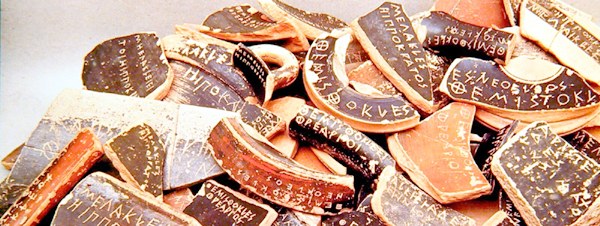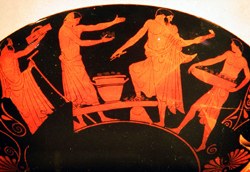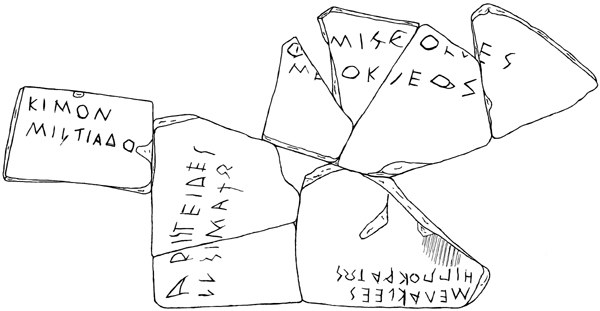The Ostraca of the Kerameikos Excavation in Athens
| Ostracism Through the shard court (ostrakismos), the Athenians of the 5th century BC could banish a fellow citizen without further justification. Annually, around January, they decided whether or not to hold a shards court (ostrakophoria). If there was a simple majority in favour, they set a day around March for the vote. The interim period was used for political propaganda. In the agora, the political centre, citizens then wrote a name usually with a pointed tool on a shard (ostrakon) before entering a demarcated district. Checks were made to see whether they were entitled to vote - and that they handed in only one shard. A quorum of 6000 votes was probably required. Those who received a simple majority had to leave Attica within ten days for ten years. His property was not touched, and on his return he could resume his place in public life. |
Hoard find in the Kerameikos: a small selection of ostraca of fine pottery against Megakles and Themistokles. |
|
A cup by the Pan Painter in Oxford (470/460 BC) probably shows the counting of the ostraca.
|
The first ostracism was carried out in 487 BC. Hipparchos, a relative of the exiled tyrant Hippias, was chosen. The following year Megacles of the Alkmeonid family had to go, and in 484 BC Xanthippos, the father of Pericles. In 482 BC, the ostracophory of Aristeides settled his dispute with Themistocles over fleet building against the Persian threat. The Ostracophoria of 471 BC led to the second exile of Megacles, whom many accused of an ostentatious lifestyle. The main rival was again Themistocles, who then had to leave Athens the following year. The ostracisation of the conservative Kimon in 461 BC marked the shift towards more democracy, and the banishment of Thucydides Melesiou around 442 BC was also a political decision, this time for Pericles. Further ostracisations are not dated with certainty. In 416 BC, the actual opponents Nicias and Alcibiades united their influence against the demagogue Hyperbolos. Because this result was apparently not wanted and the procedure thus discredited, no further ostracopy was carried out. |
| Purpose of the ostracism In the 4th century BC, constitutional theorists interpreted the law of ostracism as an emergency brake against potential tyrants, but the fixed procedure, the restriction to one victim per year and the mild punishment did not make the shard court a suitable means against an acute threat. It is rather a political ritual, a sword of Damocles over all those who wanted to be more than the people allowed them to be. |
The otherwise unknown Kallias Kratiou is associated with the Persians on many ostraca from 471 BC. |
|
The Little Owl on an ostracon against Megacles: |
Significance of the Ostraca As direct evidence, the ostraca shed light on historical events and the political discussions of the day or enrich our knowledge of the people who were in the public eye in the 5th century BC. The ostraca are also an important source for the development of language and writing. For example, some pronunciation rules can be deduced from spelling mistakes, and the development of letters from Attic to Ionic forms can be easily traced. Archaeology benefits, among other things, from the dating of utilitarian vessels. |
| Ostraca in the Kerameikos So far, more than 10,500 ostraca have been found, about 9000 of them in the German Kerameikos excavation. Most of them come from a backfilled oxbow lake of the Eridanos. They are closely interwoven by numerous adaptations and therefore form a closed complex. As hoard finds, they are representative of the vote of 471 BC and shed light on the leading men, the political situation and the pottery at that time. Some things are only revealed at second glance: beneath the executed writing there is a very fine preliminary drawing of the name and an unclear additional remark referring to "beyond" (land?). |
Not a skilled writer, because even three attempts do not bring clarity! |
|
Aristeides, Themistocles, Megacles and Kimon - they were all ostracised in a period of 20 years. These shards, however, fit together and date from 471 BC, when Megacles was banished for the second time. |
Publication of the Kerameikos ostraca Franz Willemsen, the excavator, was unable to present the publication himself. In 1995 it was passed on to Stefan Brenne and, after a period of funding by the DFG, was already close to completion in 2000. Then, in 2004, a project financed by the German Archaeological Institute started in Giessen to carry out the final work and to put it into print. Each ostracon bears an individual inscription and is therefore documented in such a way that further questions can be asked and answered on the basis of the publication. Two volumes with about 500 pages each are planned. The volume of illustrations contains characteristic vessel profiles and the graphic or photographic illustration of all ostraca, sorted according to group context or individual catalogue. The volumes, long awaited by experts, will be published in 2016 in the series "Kerameikos. Results of the Excavations" series published by the German Archaeological Institute. |
|
Publications: - E. Vanderpool, Ostracism at Athens, in: Semple Lectures II 6 (1973) 217-270. |
|
Contact: Dr. Stefan Brenne






